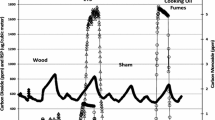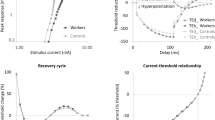Summary
To assess possible solvent-induced dysfunction of the autonomic and peripheral nervous systems, 11 solvent-exposed workers and 11 age-matched unexposed controls were examined using the coefficient of variation in electrocardiographic R-R intervals (CVRR) and the distribution of nerve conduction velocities (DCV). Two components of CVRR, i.e., the C-CVRSA and CCVMWSA, were also examined, which are considered to reflect parasympathetic and sympathetic activities, respectively. The workers had been occupationally exposed to toluene and/or solvent mixtures such as thinners, for 35–360 months. In the solvent-exposed workers, the CVRR and C-CVRSA were significantly reduced compared with unexposed controls. Similarly, the faster velocities of the DCV and median nerve conduction velocities were significantly slowed. The reduction in the CVRR was significantly correlated with duration of exposure in the solvent-exposed workers. These data, despite the small sample size and the variety of organic solvents, suggest that organic solvents may affect both the faster myelinated nerve fibers and autonomic nervous activity (principally, parasympathetic component).
Similar content being viewed by others
References
Agency for Toxic Substances and Disease Registry (1989) Toxicological profile for toluene. US Department of Health and Human Services, Atlanta
Akselrod S, Gordon D, Ubel FA, Shannon DC, Barger AC, Cohen RJ (1981) Power spectrum analysis of heart rate fluctuation: a quantitative probe of beat-to-beat cardiovascular control. Science 213:220–222
Altenkirch H, Mager J, Stoltenburg G, Helmbrecht J (1977) Toxic polyneuropathies after sniffing a glue thinner. J Neurol 214:137–152
Araki S, Yokoyama K, Murata K, Aono H (1986) Determination of the distribution of conduction velocities in workers exposed to lead, zinc and copper. Br J Ind Med 43:321–326
Araki S, Yokoyama K, Aono H, Murata K (1988) Determination of the distribution of nerve conduction velocities in chain saw operators. Br J Ind Med 45:341–344
Arito H, Tsuruta H, Nakagaki K, Tanaka S (1985) Partial insomnia, hyperactivity and hyperdipsia induced by repeated administration of toluene in rats: their relation to brain monoamine metabolism. Toxicology 37:99–110
Baker EL, Letz RE, Eisen EA, Pothier LJ, Plantamura DL, Larson M, Wolford R (1988) Neurobehavioral effects of solvents in construction painters. J Occup Med 30:116–123
Barker AT, Brown BH, Freeston H (1979) Determination of the distribution of conduction velocities in human nerve trunks. IEEE Transact Biomed Eng 26:76–81
Buiatti E, Cecchini S, Ronchi O, Dolara P, Bulgarelli G (1978) Relationship between clinical and electromyographic findings and exposure to solvents, in shoe and leather workers. Br J Ind Med 35:168–173
Eckberg DL (1983) Human sinus arrhythmia as an index of vagal cardiac outflow. J Appl Physiol 54:961–966
Fidler AT, Baker EL, Letz RE (1987) Neurobehavioural effects of occupational exposure to organic solvents among construction painters. Br J Ind Med 44:292–308
Hayano J, Yamada M, Sakakibara Y, Fujinami T, Yokoyama K, Watanabe Y, Takata K (1990) Short- and long-term effects of cigarette smoking on heart rate variability. Am J Cardiol 65:84–88
Ikeda M, Koizumi A, Kasahara M, Fujita H (1986) Combined effects of n-hexane and toluene on norepinephrine and dopamine levels in rat brain tissues after long-term exposures. Bull Environ Contam Toxicol 36:510–517
Inoue T, Takeuchi Y, Hisanaga N, Ono Y, Iwata M, Ogata M, Saito K, Sakurai H, Hara I, Matsushita T, Ikeda M (1983) A nationwide survey on organic solvent components in various solvent products: part 1. Homogeneous products such as thinners, degreasers and reagents. Ind Health 21:175–183
Juntunen J, Hupli V, Hernberg S, Luisto M (1980) Neurological picture of organic solvent poisoning in industry: a retrospective clinical study of 37 patients. Int Arch Occup Environ Health 46:219–231
Lee BK, Lee SH, Lee KM, Cho KS, Ahn KD, Kim SB, Ukai H, Nakatsuka H, Watanabe T, Ikeda M (1988) Dose-dependent increase in subjective symptom prevalence among tolueneexposed workers. Ind Health 26:11–23
Murata K, Araki S, Aono H (1987) Effects of lead, zinc and copper absorption on peripheral nerve conduction in metal workers. Int Arch Occup Environ Health 59:11–20
Murata K, Araki S, Maeda K (1991) Autonomic and peripheral nervous system dysfunction in workers exposed to hand-arm vibration: a study of R-R interval variability and distribution of nerve conduction velocities. Int Arch Occup Environ Health 63:205–211
Murata K, Araki S, Yokoyama K (1991) Assessment of peripheral, central and autonomic nervous system function in styrene workers. Am J Int Med 20: (in press)
Mutti A, Ferri F, Lommi G, Lotta S, Lucertini S, Franchini I (1982) n-Hexane induced changes in nerve conduction velocities and somatosensory evoked potentials. Int Arch Occup Environ Health 51:45–54
NIOSH (1987) Organic solvent neurotoxicity. US Department of Health and Human Services, Cincinnati (DHHS publication no 87-104)
Ogata M, Sugihara R, Kira S (1977) Quantitative determination of urinary hippuric acid and m-or p-methylhippuric acid as indices of toluene and m- or p-xylene exposure by high performance liquid chromatography. Int Arch Occup Environ Health 39:199–206
Pagani M, Lombardi F, Guzzetti S, Rimoldi O, Furlan R, Pizzinelli P, Sandrone G, Malfatto G, Dell'Orto S, Piccaluga E, Turiel M, Baselli G, Cerutti S, Malliani A (1990) Power spectral analysis of heart rate and arterial pressure variabilities as a marker of sympatho-vagal interaction in man and conscious dog. Circ Res 59:178–193
Pomerantz B, Macaulay RJB, Caudill MA, Kutz I, Adam D, Gordon D, Kilborn KM, Barger AC, Shannon DC, Cohen RJ, Benson H (1985) Assessment of autonomic function in humans by heart rate spectral analysis. Am J Physiol 249: H151–153
Saida K, Mendell JR, Weiss HS (1976) Peripheral nerve changes induced by methyl n-butyl ketone and potentiation by methyl ethyl ketone. J Neuropathol Exp Neurol 35:207–225
Sax DS, Kovacs ZL, Johnson TL, Feldman RG (1981) Clinical application of the estimation of nerve conduction velocity distribution. In: Dorfman LJ, Cummins KL, Leifer LJ (eds) Conduction velocity distributions. A population approach to electrophysiology of nerve. Liss, New York, pp 113–136
Sayers BMcA (1973) Analysis of heart rate variability. Ergonomics 16:17–32
Seppalainen AM, Lindstrom K, Martelin T (1980) Neurophysiological and psychological picture of solvent poisoning. Am J Ind Med 1:34–42
Takeuchi Y, Ono Y, Hisanaga N, Kitoh J, Sugiura Y (1980) A comparative study on the neurotoxicity of n-pentane, n-hexane, and n-heptane in the rat. Br J Ind Med 37:241–247
Takeuchi Y, Ono Y, Hisanaga N (1981) An experimental study on the combined effects of n-hexane and toluene on the peripheral nerve of the rat. Br J Ind Med 38:14–19
Thews G, Vaupel P (1985) Autonomic functions in human physiology. Springer, Berlin Heidelberg New York
Urban P, Lukas E (1990) Visual evoked potentials in rotogravure printers exposed to toluene. Br J Ind Med 47:819–823
Wang JD, Chang YC, Kao KP, Huang CC, Lin CC, Yeh WY (1986) An outbreak of n-hexane induced polyneuropathy among press proofing workers in Taipei. Am J Ind Med 10:111–118
Yokoyama K, Feldman RG, Sax DS, Salzsider BT, Kucera J (1990) Relation of distribution of conduction velocities to nerve biopsy findings in n-hexane poisoning. Muscle Nerve 13 314–320
Author information
Authors and Affiliations
Rights and permissions
About this article
Cite this article
Murata, K., Araki, S., Yokoyama, K. et al. Autonomic and peripheral nervous system dysfunction in workers exposed to mixed organic solvents. Int. Arch Occup Environ Heath 63, 335–340 (1991). https://doi.org/10.1007/BF00381584
Received:
Accepted:
Issue Date:
DOI: https://doi.org/10.1007/BF00381584




